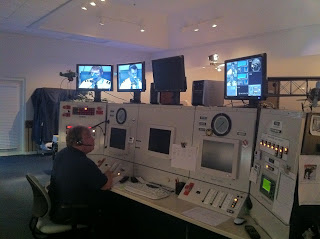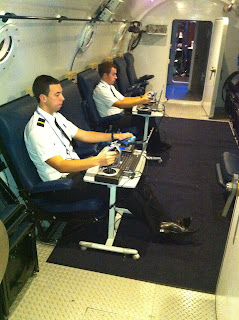A busy few days! Since Friday I have managed to get up flying twice, once in the front and once in the back but before any of that, we got to complete the Hypoxia training here in Melbourne, Florida.
I'll talk about the Hypoxia training in this post and make another update about the two flights later in the week.
Getting up at 8am on Saturday wasn't the easiest after four long days in class but come 8.45am we arrived at the training facility on the other side of the city. The building is set in what I would class as very 'Floridian' backgrounds with palm trees and bright white surroundings.
There was an area for us to sit while we waited and whilst we watched our colleagues in the chamber. As you'll see later on, there are a number of cameras fitted within and around the capsule to monitor and observe operation.
Mission control consists of a lot of Star Trek style controls with relevant cameras to monitor the process. Here is where all the changes within the chamber are conducted.
The chamber itself is filled with facing seats each with their own headset and oxygen supply. For the four of us, we would go in two sets of two. Set up inside were two laptop computers accompanied with control and throttle.
After the capsule has been sealed with two students along with a controller the pressure is reduced to that one would experience at 5,000ft. The initial feeling is a popping sensation in the ears - similar to what you would experience in any commercial flight. After all, the altitude within the cabin will rise during flight to a maximum of 8,000ft.
Having reached 5,000ft we then 'descended' back to mean sea level (MSL) pressure. This was to allow us to adapt to the changing pressure and to equalising.
The latops and accessories we were issued with each had Microsoft Flight Simulator installed and we were each set up at 15,000ft over the Rockie mountains. As we started to climb we activated the simulation and were each asked to fly particular headings and altitudes and to report frequently our speeds.
We continued to climb. Passing through 20,000ft I was certainly starting to feel that something wasn't right. My arms were starting to become quite lethargic; my chest and face quite flushed and the heart rate was increasing quite alarmingly for a seated state.
We continued to climb up to almost 23,000ft. At this point two of our dear colleagues thought it would be a good idea to fire a couple of simple questions our way from outside of the tank. Although we both answered the questions correctly, the time and effort it took was again quite startling.
We soon described our symptoms to Dr Buza and donned the oxygen masks. The change of mind state was almost instant. Two, three breathes and my senses had fully returned to their natural state. I quickly realised I was 1,000ft above my instructed altitude - something I was completely unaware of only second earlier.
When both of us were on oxygen we started the descent to 10,000ft where we could then remove the face masks.
Back to MSL we exited the chamber and sat down for a debriefing with the doctor. He went through each of our symptoms and further emphesised how important it is for each and everyone of us to be aware of these and how they could one day be very very useful.
It was a fantastic, no amazing, experience which I am sure non of us will forget about throughout our careers. We are very lucky to have such a fantastic facility and professional sat on our doorstep here in eastern Florida. For all those out here or planning to come out in the future - it is a must for any professional pilot.
As I said above, I'll update on the flights from the weekend and this week's ATPL classes later in the week. Got to get to the books!







Nice to see the Saitek X52 controllers - looks very similar to my setup!
ReplyDeleteGreat post!
Thanks Dave. Yes they're pretty decent - I would say better than those we get in the real thing!
ReplyDeleteInteresting reading, do you think in a real situation now you would be able to detect you were suffering from hypoxia in enough time to resolve the issue.
ReplyDeleteFrom what I've heard about the subject you seem to become more 'care free' which could lead to not resolving the situation.
I think I would certainly recognise at least one of the symptoms (the heavy arms) if I was to suffer from hypoxia again.
ReplyDeleteIt is something that when flying commercial aircraft is extremely uncommon and having had the expertise of Dr Buza I'm pretty certain that I will be paying more attention to the cabin altitude during my career than your average pilot!
Yes you're right, you start to lose your senses and judgement certainly becomes impaired.
The amazing thing is when you apply your mask and literally within seconds you're back to normal!
How the human body works 'eh?